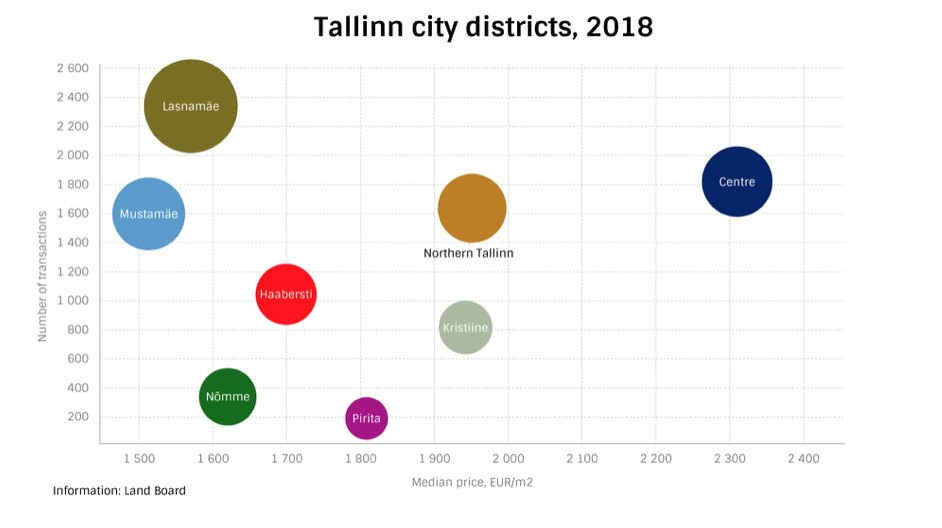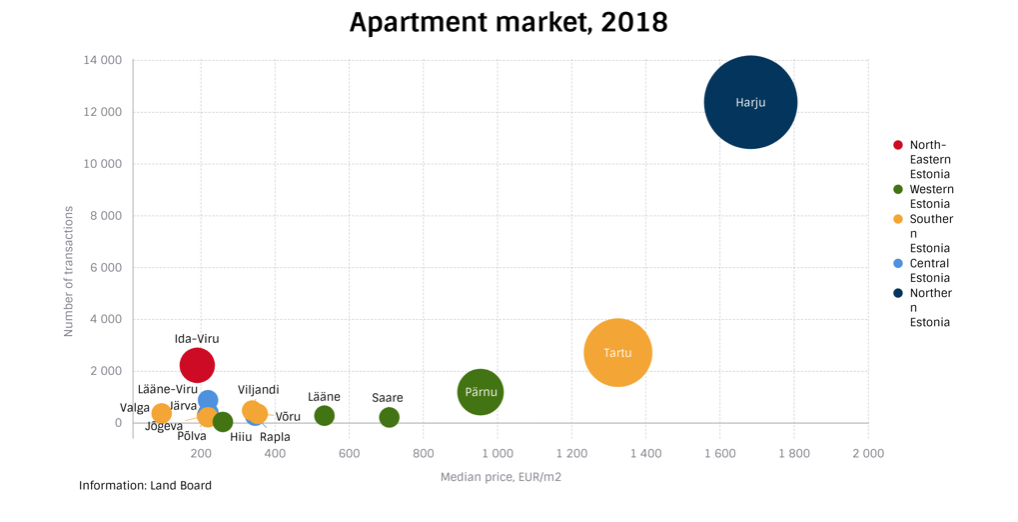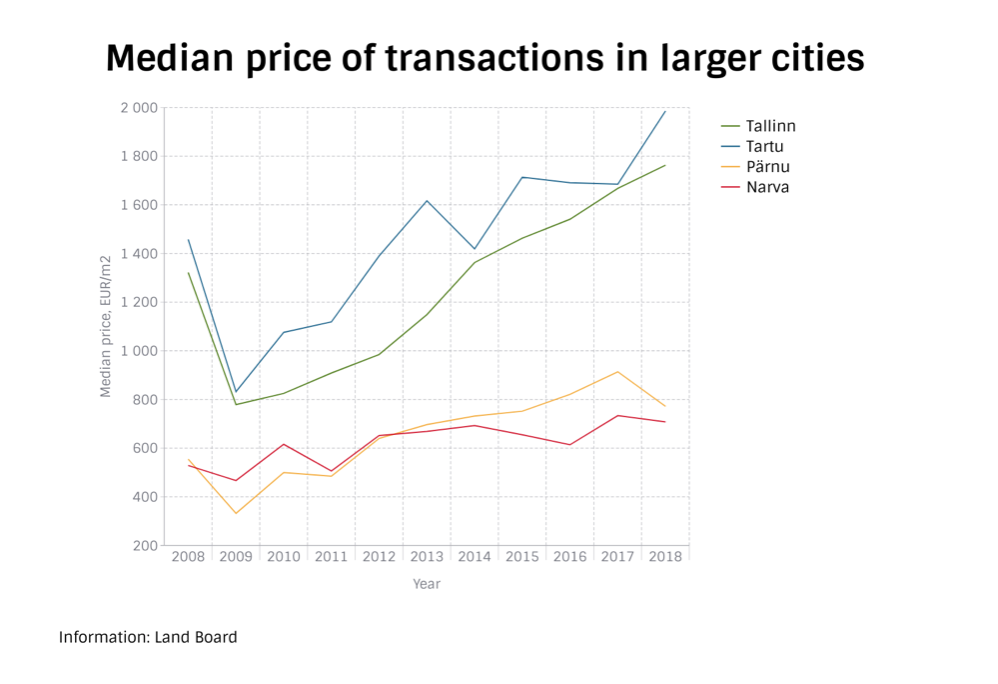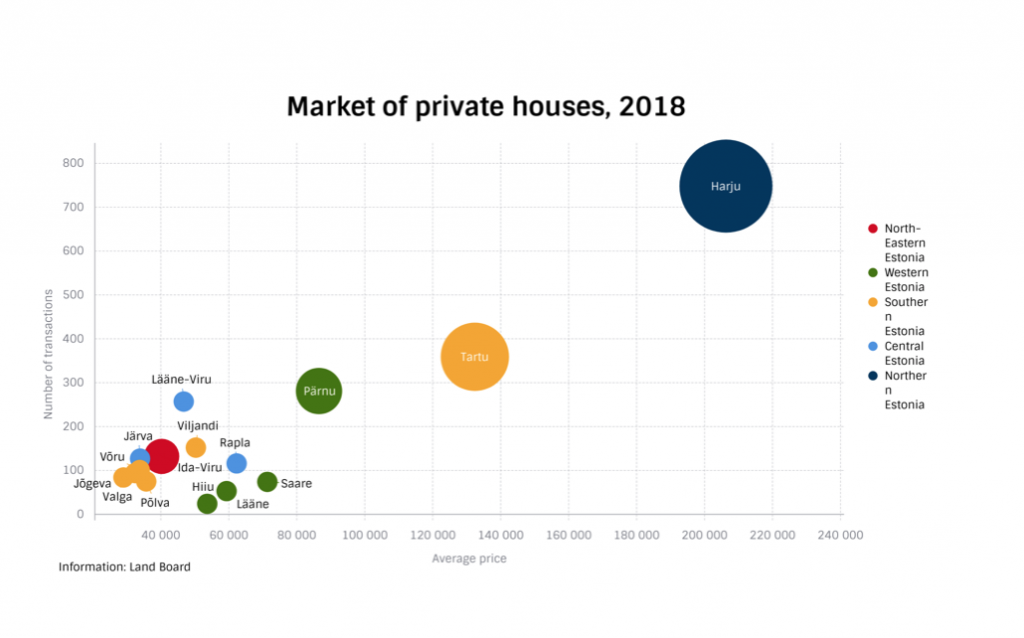In December 2018, cooling of the real estate market continued, even though during the whole year of 2018, more apartment and house transactions were concluded in Estonia than in the previous year. However, today the cooling mainly concerns the capital and is not characteristic of the whole country.
Higher input expenses, shrinking profit margins and a large number of offers have increased the insecurity of developers in spite of strong demand. Therefore, the number of new apartments completed decreased in 2018 and also the statistics of building permits showed a decline. The drop started already from the 3rd quarter and continued also in the 4th quarter based on the high baseline of the previous year.
Tallinn
In Tallinn, over 200 apartment transactions less were concluded in December in comparison to the same period last year. However, thanks to the usual higher share of new developments at the end of the year, the median price grew to the highest level of all time – 1,858 EUR/m2. The previous record-breaking figures belonged to last December and June of 2018 when the median price was 1,808 EUR/m2.
In total, 9,698 sale/purchase transactions of apartment ownerships were carried out during the year, which was slightly over 60 transactions less than during the previous year. Also the growth in the median price of the transactions slowed down. If in 2017 it was 8.2%, in 2018 the prices increased by 5.7%. Looking at the sales speed of the new apartments brought into the market in the past months, there is a risk that the demand may decrease due to high asking prices.
In 2018, the districts of Tallinn mainly went through a slight drop in the number of transactions. The only bigger exception was Lasnamäe city district where due to large building volumes, the number of transactions increased by over 140. Transaction prices increased most in Northern Tallinn (11.4%), the price increase in other areas was mainly between 5% and 7%. The median price of transactions was the highest in the Centre, which was the only area where it exceeded the line of 2,000 EUR/m2.
Other larger cities
In Tartu, the number of apartments sold in 2018 increased considerably, even by 300 in comparison to year 2017. It is worth mentioning that during the recent years, the number of transactions in Tartu was at standstill, and thus the large increase is greatly based on the low baseline of the previous year. The increase in Tartu will probably slow down this year, especially considering the fact that the 300 additional transactions also brought along a growth in the median price of transactions (1,275→1,387 EUR/m2), increasing by 8.8%. However, unlike in Tallinn, the optimism of developers is greater in Tartu, which is also characterized by an increased number of apartments that have received building permits.
After the quick increase in 2017, the number of transactions in Pärnu went through a larger decline of the number of transactions. The number of transactions dropped to the level of 2015. In such a small market it is unthinkable to have the same powerful development; the market potential and the circle of buyers are so limited that major rises and falls are an inherent part of the small but valued market. The median price of transactions continued to grow at a lower rate than the market average, increasing by 6.5% in comparison to year 2017. In total, 772 transactions were concluded in Pärnu in 2017 with a median price of 1,153 EUR/m2.
Even though the median price of transactions dropped in Narva city for the fourth consecutive year, and the number of transactions decreased by more than 20 in comparison to year 2017, the end of the year showed hope in Narva. After the price reduction in summer and early autumn, the median price of transactions increased again over 400 EUR/m2 in November and December, and also the decline in asking price has slowed down. In total, 708 transactions were concluded in Narva during the year, with a median price of 393 EUR/m2.
Counties
For both the other larger cities (e.g. Narva and Pärnu) and the rest of Estonia, it may be said that the decrease in population and especially the emigration of young people in the best apartment-buying age no longer increased the number of transactions in 2018. When leaving out Harju and Tartu counties, in the rest of the 13 counties, the number of transactions increased only in three, which suggests that the socioeconomic conditions and the declining population have created a line that is difficult to cross for most of the counties in the current circumstances. A more positive highlight was on the counties where the number of transactions increased due to a low baseline or a larger decline last year. Thus, in 2018, the number of transactions increased in Põlva County by nearly 50 transactions after the drop of over 20 transactions in 2017. A major climber was also Ida-Viru County where 2,230 transactions were concluded in 2018, i.e. 72 more than in 2017. The biggest decline could be observed in Pärnu County: in 2017, 1,350 transactions were concluded in the county but 1,196 transactions in 2018.
Due to improved incomes and low unemployment, the prices continued to increase, the median price of transactions dropped only in four counties (Hiiu County, Ida-Viru County, Valga County, Viljandi County), whereas Valga County was the only county where prices dropped for the second year in a row. Of absolute prices, the prices increased most in Tartu and Harju counties, in the rest of the counties, the price increase was actually very small, mainly 20 to 50 EUR/m2.
In the magnets of counties, the price increase was quicker than the average level of the county, mostly those are small places where prices are increasing outside Tallinn, Tartu or Pärnu. Of county centres, Kuressaare was the most valued one, where the median price of transactions in 2018 was 846 EUR/m2, followed by Rakvere and Viljandi with an almost equal median price of 740 EUR/m2. In either one of the cities, the median price of transactions increased over 100 EUR/m2, but like in other cities, the number of transactions dropped. A good increase could also be seen in Haapsalu where the median price of transactions increased even by 137 EUR/m2, rising above 700 EUR/m2.
Houses
2018 was a good year also in the market of private houses, as both the number of transactions and the average price increased in comparison to 2017. 2,679 sale/purchase transactions of residential houses were concluded in all of Estonia, the average price of the transactions was over 106,000 euros, i.e. nearly 9,000 euros more than in 2017. However, similarly to the apartment market, the increase in the number of transactions was not extensive, the number of transactions decreased in 10 counties, the biggest risers were Lääne-Viru County (+50 transactions) and Tartu County (+24 transactions). The average price increased basically in every county, it was the highest in Harju County, which was the only county where it crossed the line of 200,000, and in Tartu County where the figure was over 130,000 euros. In spite of large expenses related to private houses and the low liquidity of the market, the number of building permits issued has also increased. As the market of new developments for apartments is limited to only a few counties, the people who have wanted new residential premises in rural areas have mainly renovated their existing apartments or started to build a house on their own.





